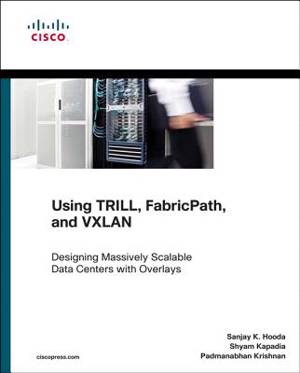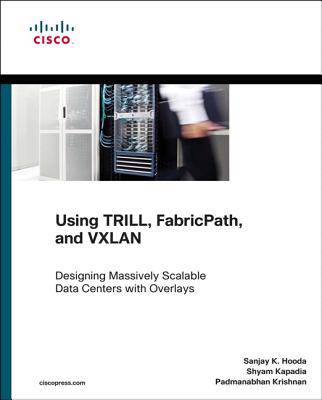
- Retrait gratuit dans votre magasin Club
- 7.000.000 titres dans notre catalogue
- Payer en toute sécurité
- Toujours un magasin près de chez vous
- Retrait gratuit dans votre magasin Club
- 7.000.0000 titres dans notre catalogue
- Payer en toute sécurité
- Toujours un magasin près de chez vous
Using TRILL, FabricPath, and VXLAN
Designing Massively Scalable Data Centers (MSDC) with Overlays
Sanjay Hooda, Shyam Kapadia, Padmanabhan Krishnan
62,45 €
+ 124 points
Description
Using TRILL, FabricPath, and VXLAN Designing Massively Scalable Data Centers with Overlays TRILL, FabricPath, and VXLAN overlays help you distribute data traffic far more effectively, dramatically improving utilization in even the largest data center networks. Using TRILL, FabricPath, and VXLAN is the first practical and comprehensive guide to planning and establishing these high-efficiency overlay networks. The authors begin by reviewing today's fast-growing data center requirements, and making a strong case for overlays in the Massive Scale Data Center (MSDC). Next, they introduce each leading technology option, including FabricPath, TRILL, LISP, VXLAN, NVGRE, OTV, and Shortest Path Bridging (SPB). They also present a chapter-length introduction to IS-IS, focusing on details relevant to the control of FabricPath and TRILL networks. Building on this foundation, they offer in-depth coverage of FabricPath: its advantages, architecture, forwarding, configuration, verification, and benefits in Layer-2 networks. Through examples, they explain TRILL's architecture, functionality, and forwarding behavior, focusing especially on data flow. They also fully address VXLAN as a solution for realizing IP-based data center fabrics, including multi-tenant cloud applications. Using TRILL, FabricPath, and VXLAN provides detailed strategies and methodologies for FabricPath, TRILL, and VXLAN deployment and migration, as well as best practices for management and troubleshooting. It also presents three detailed implementation scenarios, each reflecting realistic data center challenges. In particular, the authors show how to integrate multiple overlay technologies into a single end-to-end solution that offers exceptional flexibility, agility, and availability. Sanjay K. Hooda is principal engineer in Catalyst switching software engineering at Cisco. He has more than 15 years of network design and implementation experience in large enterprise environments, and has participated in IETF standards activities. His interests include wireless, multicast, TRILL, FabricPath, High Availability, ISSU, and IPv6. He is co-author of IPv6 for Enterprise Networks. Shyam Kapadia, Technical Leader at Cisco's Data Center Group (DCG), was an integral part of the team that delivered the next-generation Catalyst 6500 Sup 2T (2 Terabyte) platform. Since then, he has focused on developing new solutions for data center environments. He holds a Ph.D. in computer science from USC, where his research encompassed wired, wireless, ad hoc, vehicular, and sensor networks. Padmanabhan Krishnan has more than 12 years of experience in networking and telecommunications, including 7 at Cisco. His recent experience has included providing data path solutions for TRILL in the Catalyst 6500 Sup 2T Platform using FPGA, as well as design and development of platform core infrastructure and L2 features. n Discover how overlays can address data center network problems ranging from scalability to rapid provisioning n Examine popular data center overlay examples n Learn about extensions to IS-IS for TRILL and FabricPath n Use FabricPath, TRILL, and VXLAN to simplify configuration, improve performance and availability, optimize efficiency, and limit table size n Learn about FabricPath control and data plane architecture details n Review example FabricPath configurations on Cisco Nexus 7000/6000/5000 switches n Understand TRILL concepts and architecture, including overlay header, control and data plane, and MAC address learning n Learn about VXLAN architecture details and packet forwarding n Review example VXLAN configurations on a Cisco Nexus 1000V distributed virtual switch n Implement TRILL/FabricPath networks with VXLAN to virtualized servers in an intra-data center environment n Connect multiple traditional data centers using an OTV overlay as a Layer 2 extension n Use OTV overlays to connect sites running FabricPath, TRILL, or both
Spécifications
Parties prenantes
- Auteur(s) :
- Editeur:
Contenu
- Nombre de pages :
- 344
- Langue:
- Anglais
- Collection :
Caractéristiques
- EAN:
- 9781587143939
- Date de parution :
- 06-02-14
- Format:
- Livre broché
- Format numérique:
- Trade paperback (VS)
- Dimensions :
- 189 mm x 233 mm
- Poids :
- 603 g

Les avis
Nous publions uniquement les avis qui respectent les conditions requises. Consultez nos conditions pour les avis.






